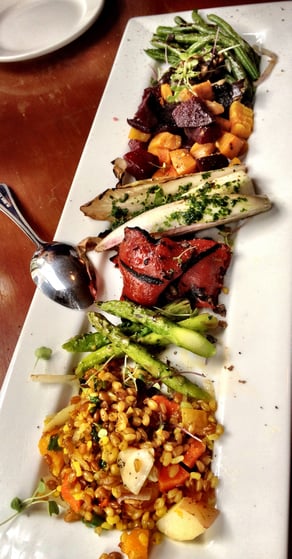One of my favorite dishes has always been the simple antipasto. While I was growing up, it was a staple of our holiday meals, and I've continued the tradition of serving antipasto throughout the Christmas season. My husband and kids like antipasto well enough, but to me, the dish is the absolute pinnacle of gustatory perfezione. Give me a hunk of Italian bread and a glass of vino alongside a plate of olives, "giardiniera" (pickled vegetables), mozzarella cheese, anchovies, cherry tomatoes, roasted peppers, provolone, and marinated artichoke hearts, and I'm. In. Heaven.
What about the Genoa salami? And the prosciutto? And where's the "soppressata" (dried salami)?
Well, there isn't prosciutto or salami of any kind on my antipasto plate. That's because several years ago I adopted a who-needs-it attitude towards meat, and since then, I've been discovering new and compelling reasons for being a Catholic Vegetarian.
Want to know more about Catholic vegetarianism? Read on for a Very Basic Primer.
What's a Vegetarian Diet?
A vegetarian diet is comprised of foods that come from plants: fruits, vegetables, dried beans, grains, seeds, and nuts. There are several kinds of vegetarian diet, but although they differ one from another in the permissibility of certain foods, all of them exclude meat.
The Health Benefits of a Vegetarian Diet
The low-fat, high-fiber characteristics of the typical vegetarian diet put vegetarians at lower risk for developing obesity, coronary heart disease, high blood pressure, diabetes, and certain forms of cancer. When following a meatless diet it's especially important to include a wide variety of foods and to guard against overconsumption of sweets and fatty foods, but the disease-fighting benefits are well worth the effort.
Think of it this way: Catholics observe meatless Fridays and reap the spiritual benefits. Why not give up meat more often than once a week and reap the physical benefits as well?
The Church’s Teaching on Vegetarianism
According to the Catechism, “It is legitimate to use animals for food and clothing” (CCC2417), so Catholics are free to choose whether to include meat in their diets. However, the Catechism goes on to state that it is "contrary to human dignity to cause animals to suffer or die needlessly" (CCC 2418), prompting Catholics to also consider the means by which meat is obtained.
Are animals raised for meat being treated humanely or are they the victims of the “industrial use" condemned by Pope Emeritus Benedict? Is arable land which would yield grain and produce to feed people being used instead to grow cattle feed? Do the production methods of any given meat-provider reflect a "religious respect for the integrity of creation" (CCC 2415-2418)? Ultimately, Catholics are obligated to apply the principles of good stewardship when making decisions about what to eat.
Mindful and Meatless
Mindfulness is an important part of Catholic vegetarianism. Reflect on the God-given gifts of field and garden; be fully aware of what you are eating while you are eating; remember that nourishing your family with wholesome foods is a privilege. As both a steward of God's creation and a recipient of its bounty, the Catholic vegetarian can enjoy the fruits of the earth with a grateful heart and a clear conscience.
A meatless diet is by no means the only choice of diet for the conscientious Catholic. But it is certainly an option to weigh when making decisions about what to eat. The most important thing to bear in mind is that, while vegetarianism is merely a way of life, Jesus Christ is the Way and the Life.
Copyright 2015 Celeste Behe
About the Author

Guest
We welcome guest contributors who graciously volunteer their writing for our readers. Please support our guest writers by visiting their sites, purchasing their work, and leaving comments to thank them for sharing their gifts here on CatholicMom.com. To inquire about serving as a guest contributor, contact editor@CatholicMom.com.



.png?width=1806&height=731&name=CatholicMom_hcfm_logo1_pos_871c_2728c%20(002).png)
Comments